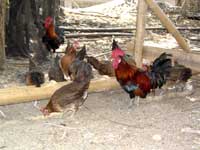Scientists urge farmers to bank on Darag native chicken's potentials

After seeing that the Darag native chicken continues to draw in great demand from consumers, scientists urge farmers to capitalize in the Darag's potentials.
The Philippine Council for Agriculture, Forestry and Natural Resources Research and Development (Pcarrd), through its regional consortium, Western Visayas Agriculture and Resources Research and Development Consortium (Wesvarrdec), implemented the S&T Anchor Program for Philippine Native Chicken to promote this commodity.
The Program is organized in collaboration with Wesvarrdec member-agencies with West Visayas State University (WVSU) as main implementing agency. WVSU has pioneering researches on Darag in the region.
Other collaborating agencies are DA-Wesviarc, RFU-VI, Capiz State University, UPV, DENR, Iscof-Dingle Campus, DA-Guimaras, Aklan State University and Provincial Veterinary Offices of Aklan and Guimaras LGUs .
The Program emphasizes the major attributes of the Darag which are highly beneficial for farmers and consumers: its unique flavor, medicinal value, high resistance to weather and diseases, minimal requirement for management intervention and, lately, its being organic.
The Darag is best known for its unique flavor, taste and texture of meat that is preferred by most consumers.
According to Dr. Synan Baguio, Senior Science Research Specialist for Pcarrd, the distinct taste of the native chicken can be attributed to the presence of free amino acids in their bodies.
Amino acids, like betaine and aspartic acid, are the basic building blocks for proteins that chickens need for faster muscle growth. Since native chickens are smaller and grow more slowly than broilers, they have plenty of unused free amino acids.
"Amino acids are also the basic ingredients for monosodium glutamate, or vetsin, so they work as a naturally occurring flavor enhancer," Baguio said.
This taste may also be attributed to the fact that the chickens are kept free-range in the backyard and nearby fields of smallhold farmers. This gives them enough muscle exercise and freedom to feed on naturally occurring food materials in the area.
According to geneticists and breeders, the natural selection process of native chickens under local environment caused it to develop patterns of behavior that allows them to survive and reproduce even in the most marginal environment and with minimal management intervention.
These chickens are left in the fields to fend for themselves leaving minimal inputs of feeds and medicine, including breeding, treatment and housing management.
Today, more and more consumers, especially the Chinese, are becoming firm advocates of the health and medicinal value of the native chicken. Researches in different parts of Asia discovered the "neutraceutical" value of these chickens. Experiments showed that patients recover faster if fed native chicken once a day.
As of late, trends in the industry show that consumers' preference lean more towards organically produced products. The absence or minimal infusion of chemicals in the native chickens' feeds means that they are more organic than its commercial counterparts.
"Considering the great demand and the potential of Darag native chicken, it is high time for the farmers to embark on this business," Baguio said.
(GC Castro)
